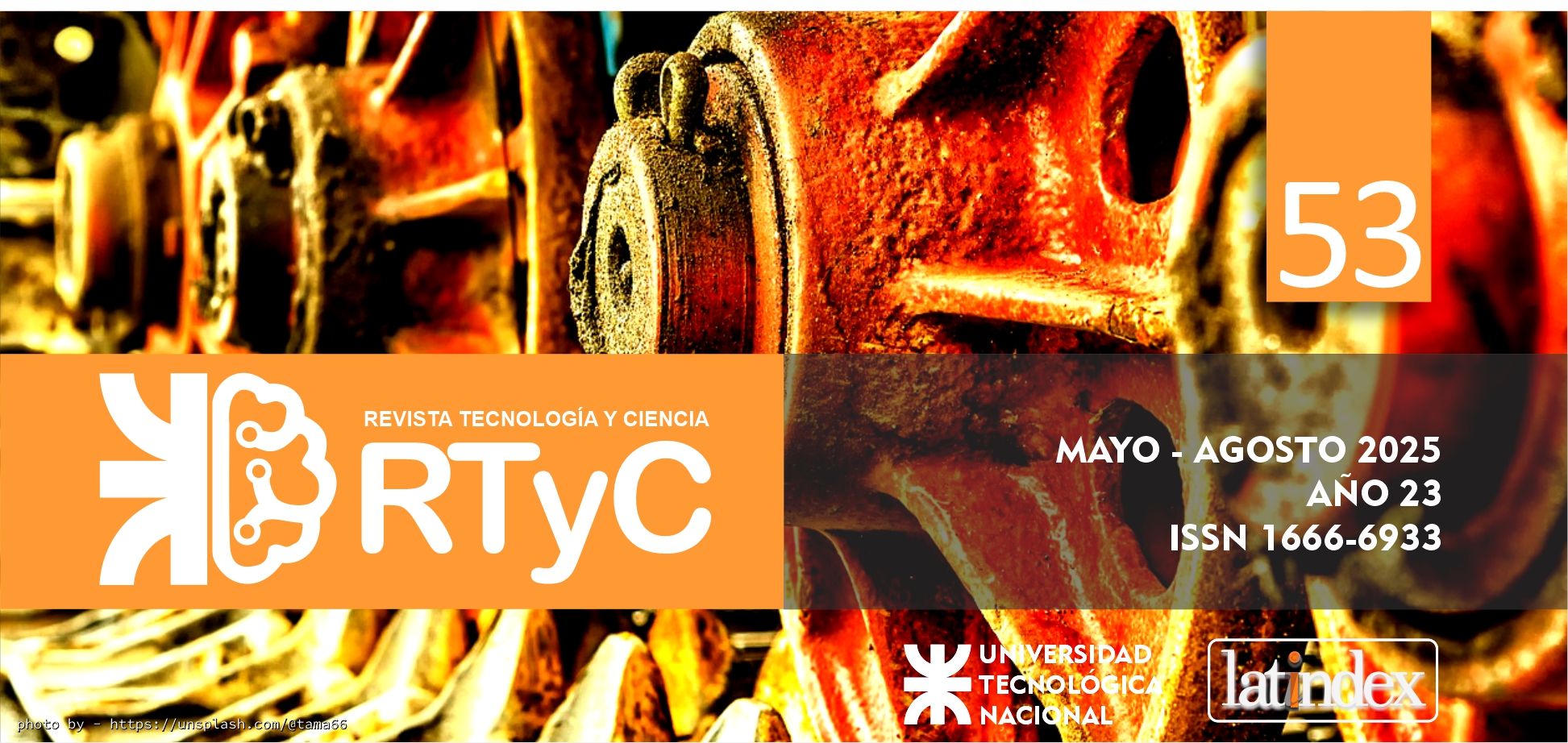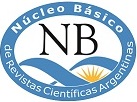Single walled carbon nanohorns as containers for molecular hydrogen
DOI:
https://doi.org/10.33414/rtyc.53.15-25.2025Keywords:
SWCNH, H2 nano-storageAbstract
Single-walled carbon nanohorns (SWCNHs) possess unique properties with great potential for nanotechnological applications. Among their potential future uses is the stable storage of molecular hydrogen (H2) at the nanoscale. The interaction between SWCNHs and H2 can be studied using atomistic simulations, which not only offer results comparable with experimental data but also provide information difficult to obtain by other means.
In particular, molecular dynamics (MD) is key, as it allows the analysis of the evolution of atoms and molecules over time, providing detailed insight into the atomic motion and thermodynamics of the system. In this work, MD with the LAMMPS code and the AIREBO reactive potential are used to examine the behavior of a SWCNH with a volume of approximately 8 nm3, including configurations with 38, 76, 152, and 304 H2 molecules inside. The stability of the system, the energy statistics and the interatomic topology are evaluated, in addition to determining the H2 pressure inside the SWCNHs in a temperature range between 200 K and 1000 K, finding a good agreement with experimental results in the gas phase.
Downloads
References
Almeida, E. R., De Souza, L. A., De Almeida, W. B., & Dos Santos, H. F. (2019). Molecular dynamics of carbon nanohorns and their complexes with cisplatin in aqueous solution. Journal of Molecular Graphics and Modelling, 89, 167-177. https://doi.org/10.1016/j.jmgm.2019.03.015
Arti, N., Alam, N., & Ansari, J. R. (2024). Nanostructures and fascinating properties of carbon nanohorns. En Handbook of Functionalized Carbon Nanostructures (pp. 351–389). Springer. https://doi.org/10.1007/978-3-031-32150-4_10.
Bhatt, M. D., Kim, H., & Kim, G. (2022). Various defects in graphene: A review. RSC Advances, 33, 1-15. https://doi.org/10.1039/D2RA01436J.
Chen, B.-H. (2014). Mechanical response of hydrogen-filled single-walled carbon nanotubes under torsion. International Journal of Hydrogen Energy, 39(3), 1382-1389. https://doi.org/10.1016/j.ijhydene.2013.10.121.
Chen, B.-H., & Kung, C. (2020). Quantum confinement and torsional responses of single-wall carbon nanotubes filled with hydrogen molecules. International Journal of Hydrogen Energy, 45(58), 33798-33806. https://doi.org/10.1016/j.ijhydene.2020.09.092.
Chen, G., Peng, Q., Mizuseki, H., & Kawazoe, Y. (2010). Theoretical investigation of hydrogen storage ability of a carbon nanohorn. Computational Materials Science, 49(4, Supplement), S378-S382. https://doi.org/10.1016/j.commatsci.2009.12.013.
Crespo, E. A., Braschi, F. U., & Bringa, E. M. (2018). Almacenamiento de H₂ a escala nanométrica: Un estudio por dinámica molecular. Rumbos Tecnológicos, 10, 45-60. https://rumbostecnologicos.utnfrainvestigacionyposgrado.com/volumenes/rumbos-10/almacenamiento-de-h2-a-escala-nanometrica-un-estudio-por-dinamica-molecular/
Comisso, N., Berlouis, L. E. A., Morrow, J., & Pagura, C. (2010). Changes in hydrogen storage properties of carbon nano-horns submitted to thermal oxidation. International Journal of Hydrogen Energy, 35(17), 9070-9081. https://doi.org/10.1016/j.ijhydene.2010.06.034.
Dubyey, L., Ukrainczyk, N., Yadav, S., Izadifar, M., Schneider, J. J., & Koenders, E. (2024). Carbon nanotubes and nanohorns in geopolymers: A study on chemical, physical and mechanical properties. Materials & Design, 240, 112851. https://doi.org/10.1016/j.matdes.2024.112851.
Dethan, J. F. N., & Swamy, V. (2022). Mechanical and thermal properties of carbon nanotubes and boron nitride nanotubes for fuel cells and hydrogen storage applications: A comparative review of molecular dynamics studies. International Journal of Hydrogen Energy, 47(59), 24916-24944. https://doi.org/10.1016/j.ijhydene.2022.05.240.
Fresco-Cala, B., López-Lorente, Á. I., & Cárdenas, S. (2018). Monolithic solid based on single-walled carbon nanohorns: Preparation, characterization, and practical evaluation as a sorbent. Nanomaterials, 8(6), 370. https://doi.org/10.3390/nano8060370.
Liao, R.-Z., Wei, S., Yi, W.-J., Chen, J.-H., & Yue, X.-Z. (2025). Synergistic effect of RuNi alloy supported by carbon nanohorns for boosted hydrogen evolution from ammonia borane hydrolysis. Journal of Colloid and Interface Science, 690, 137264. https://doi.org/10.1016/j.jcis.2025.137264.
Liu, X., Ying, Y., & Ping, J. (2020). Structure, synthesis, and sensing applications of single-walled carbon nanohorns. Biosensors and Bioelectronics, 167, 112495. https://doi.org/10.1016/j.bios.2020.112495.
Iijima, S. (2002). Carbon nanotubes: past, present, and future. Physica B: Condensed Matter, 323(1–4), 1-5. https://doi.org/10.1016/S0921-4526(02)00869-4.
Iijima, S., Yudasaka, M., Yamada, R., Bandow, S., Suenaga, K., Kokai, F., & Takahashi, K. (1999). Nano-aggregates of single-walled graphitic carbon nano-horns. Chemical Physics Letters, 309(3–4), 165-170. https://doi.org/10.1016/S0009-2614(99)00642-9.
Kagkoura, A., Ojeda-Galván, H. J., Quintana, M., & Tagmatarchis, N. (2023). Carbon dots strongly immobilized onto carbon nanohorns as non-metal heterostructure with high electrocatalytic activity towards protons reduction in hydrogen evolution reaction. Small, 19(31), 2208285. https://doi.org/10.1002/smll.202208285.
Kowalczyk, P., Terzyk, A. P., Gauden, P. A., Furmaniak, S., & Kaneko, K. (2014). Toward in silico modeling of palladium–hydrogen–carbon nanohorn nanocomposites. Physical Chemistry Chemical Physics, 16(23), 11763-11769. https://doi.org/10.1039/C4CP01345J.
Nguyen, T. A., & Assadi, A. A. (2018). Smart nanocontainers: Preparation, loading/release processes and applications. Kenkyu Journal of Nanotechnology & Nanoscience, 4(S1), 1-6. https://doi.org/10.31872/2018/KJNN-S1-100101.
National Institute of Standards and Technology. (s.f.). NIST Chemistry WebBook. Recuperado el 22 de mayo de 2025, de https://webbook.nist.gov.
Pagura, C., Barison, S., Mortalò, C., Comisso, N., & Schiavon, M. (2012). Large scale and low cost production of pristine and oxidized single wall carbon nanohorns as material for hydrogen storage. Nanoscience and Nanotechnology Letters, 4(2), 160-164. https://doi.org/10.1166/nnl.2012.1308.
Pandit, J., Alam, M. S., Javed, M. N., Waziri, A., & Imam, S. S. (2023). Emerging roles of carbon nanohorns as sustainable nanomaterials in sensor, catalyst, and biomedical applications. En Handbook of Green and Sustainable Nanotechnology (pp. 1721-1747). Springer. https://doi.org/10.1007/978-3-031-16101-8_48.
Qi, Y., & Miyako, E. (2025). Multifunctional magnetic ionic liquid-carbon nanohorn complexes for targeted cancer theranostics. Small Science, 5(3), 202400640. https://doi.org/10.1002/smsc.202400640.
Rungnim, C., Faungnawakij, K., Sano, N., Kungwan, N., & Namuangruk, S. (2018). Hydrogen storage performance of platinum supported carbon nanohorns: A DFT study of reaction mechanisms, thermodynamics, and kinetics. International Journal of Hydrogen Energy, 43(52), 23336-23345. https://doi.org/10.1016/j.ijhydene.2018.10.211.
Serban, B. C., Bumbac, M., Buiu, O., Cobianau, C., Brezeanu, M., & Nicolescu C. (2018) Carbon nanohorns and their nanocomposites synthesis, properties and aplications. A concise review. Annals of the Academy of Romanian Scientists Series on Science and Technology of Information Volume 11, Number 2/2018. https://www.researchgate.net/publication/329782184.
Serban, B. C., Buiu, O., Dumbravescu, N., Brezeanu, M., Cobianu, C., Bumbac, M., & Nicolescu, M. (2024). Some considerations about the sensing mechanisms and electrical response of carbon nanohorns–based gas sensors. Romanian Journal of Information Science and Technology, 27(2), 137-150. https://doi.org/10.59277/ROMJIST.2024.2.02.
Shi, K., Smith, E. R., Santiso, E. E., & Gubbins, K. E. (2023). A perspective on the microscopic pressure (stress) tensor: History, current understanding, and future challenges. The Journal of Chemical Physics, 158(4), 040901. https://doi.org/10.1063/5.0132487.
Stuart, S. J., Tutein, A. B., & Harrison, J. A. (2000). A reactive potential for hydrocarbons with intermolecular interactions. The Journal of Chemical Physics, 112(14), 6472-6486. https://doi.org/10.1063/1.481208.
Thompson, A. P., Aktulga, H. M., Berger, R., Bolintineanu, D. S., Brown, W. M., Crozier, P. S., in ‘t Veld, P. J., Kohlmeyer, A., Moore, S. G., Nguyen, T. D., Shan, R., Stevens, M. J., Tranchida, J., Trott, C., & Plimpton, S. J. (2022). LAMMPS - a flexible simulation tool for particle-based materials modeling at the atomic, meso, and continuum scales. Computer Physics Communications, 271, 108171. https://doi.org/10.1016/j.cpc.2021.108171.
Vijayaraghavan, V., Dethan, J. F. N., & Gao, L. (2019). Torsional mechanics of single walled carbon nanotubes with hydrogen for energy storage and fuel cell applications. Science China Physics, Mechanics & Astronomy, 62, 34611. https://doi.org/10.1007/s11433-018-9270-7.
Vijayaraghavan, V., Dethan, J. F. N., & Garg, A. (2018a). Nanomechanics and modelling of hydrogen stored carbon nanotubes under compression for PEM fuel cell applications. Computational Materials Science, 146, 176-183. https://doi.org/10.1016/j.commatsci.2018.01.041.
Vijayaraghavan, V., Dethan, J. F. N., & Garg, A. (2018b). Tensile loading characteristics of hydrogen stored carbon nanotubes in PEM fuel cell operating conditions using molecular dynamics simulation. Molecular Simulation, 44(9), 736-742. https://doi.org/10.1080/08927022.2018.1445246.
Zehra, S., Mobin, M., Aslam, R., & Bhat, S. U. I. (2023). Nanocontainers: A comprehensive review on their application in the stimuli-responsive smart functional coatings. Progress in Organic Coatings, 176, 107389. https://doi.org/10.1016/j.porgcoat.2022.107389.
Xie, Z., Lu, S., Peng, H., Liu, Y., Chen, J., Zhang, D., Liu, Y., Yang, B., & Liang, F. (2024). Regulating the structure of single-walled carbon nanohorns for impedance matching and electromagnetic wave absorption. ACS Applied Nano Materials, 7(22), 25921–25930. https://doi.org/10.1021/acsanm.4c05090.
Zhou, L. G., & Shi, S. Q. (2002). Molecular dynamic simulations on tensile mechanical properties of single-walled carbon nanotubes with and without hydrogen storage. Computational Materials Science, 23(1–4), 166-174. https://doi.org/10.1016/S0927-0256(01)00233-6.
Published
How to Cite
Issue
Section
License
Copyright (c) 2025 Eduardo Ariel Crespo, Juan Manuel González, Mirtha Azucena Orozco, Eduardo Marcial Bringa

This work is licensed under a Creative Commons Attribution-NonCommercial 4.0 International License.

















